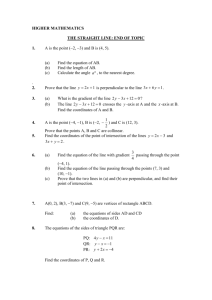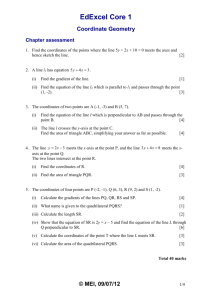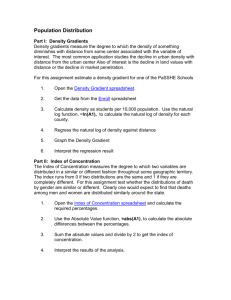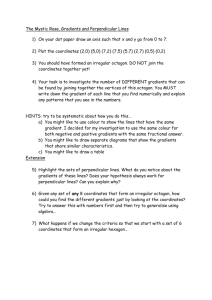SPM Additional Mathematics- by KBJIM
advertisement
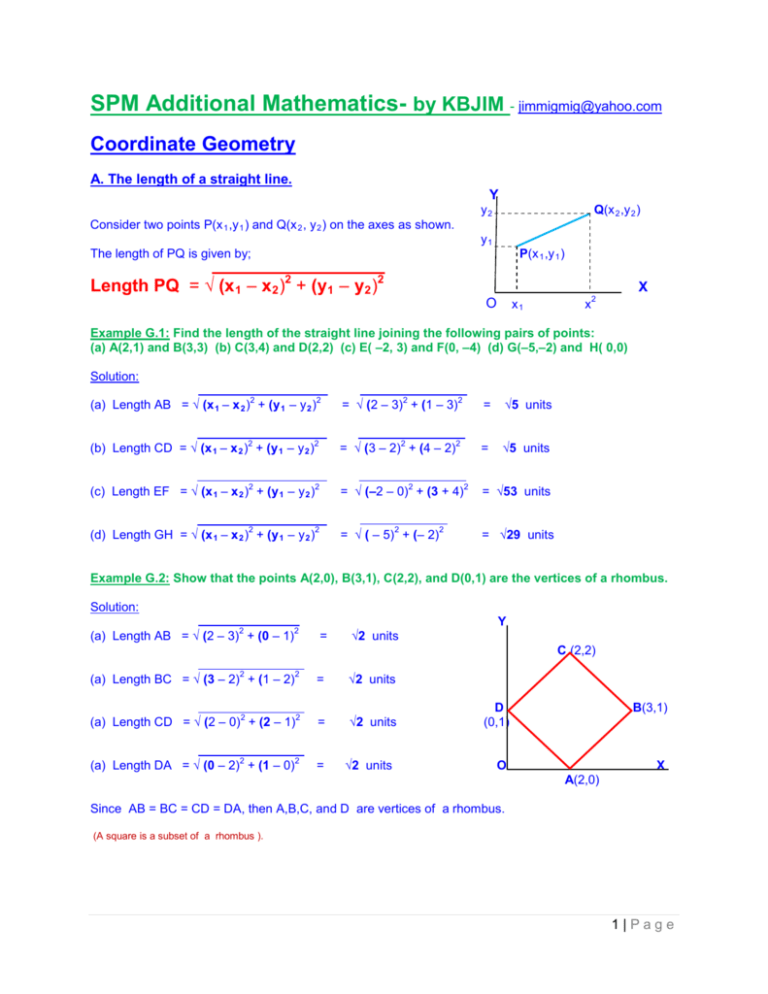
SPM Additional Mathematics- by KBJIM - jimmigmig@yahoo.com Coordinate Geometry A. The length of a straight line. Y y2 Q(x 2 ,y 2 ) Consider two points P(x 1 ,y 1 ) and Q(x 2 , y 2 ) on the axes as shown. y1 The length of PQ is given by; P(x 1 ,y 1 ) Length PQ = √ (x 1 – x 2 )2 + (y1 – y2 )2 X O x1 x 2 Example G.1: Find the length of the straight line joining the following pairs of points: (a) A(2,1) and B(3,3) (b) C(3,4) and D(2,2) (c) E( –2, 3) and F(0, –4) (d) G(–5,–2) and H( 0,0) Solution: 2 = √ (2 – 3) + (1 – 3) 2 = √ (3 – 2) + (4 – 2) (a) Length AB = √ (x 1 – x 2 ) + (y 1 – y 2 ) 2 (b) Length CD = √ (x 1 – x 2 ) + (y 1 – y 2 ) 2 2 2 2 = √5 units 2 = √5 units (c) Length EF = √ (x 1 – x 2 ) + (y 1 – y 2 ) 2 = √ (–2 – 0) + (3 + 4) (d) Length GH = √ (x 1 – x 2 ) + (y 1 – y 2 ) 2 = √ ( – 5) + (– 2) 2 2 2 2 2 2 = √53 units = √29 units Example G.2: Show that the points A(2,0), B(3,1), C(2,2), and D(0,1) are the vertices of a rhombus. Solution: (a) Length AB = √ (2 – 3) + (0 – 1) 2 2 = √2 units Y C (2,2) (a) Length BC = √ (3 – 2) + (1 – 2) 2 = √2 units 2 = √2 units 2 = 2 (a) Length CD = √ (2 – 0) + (2 – 1) 2 (a) Length DA = √ (0 – 2) + (1 – 0) 2 √2 units D (0,1) B(3,1) O X A(2,0) Since AB = BC = CD = DA, then A,B,C, and D are vertices of a rhombus. (A square is a subset of a rhombus ). 1|Page B. The mid-point of a straight line. 1. The coordinates of the mid-point joining P(x 1 ,y 1 ) and Q(x 2 , y 2 ) is given by: Mid-point of PQ = ( x 1 + x 2 , y1 + y2 ) 2 2 Example G.3: A(1, 2), B(5, 3), C(7, 6) and D(x, y) are the vertices of a parallelogram ABCD. Find the coordinates of D. Solution: Y Mid-point of BD = mid point of AC C(7,6) ( x +5 , y + 3) = (1 + 7 , 2 + 6) = ( 4 , 4 ) 2 2 2 2 Therefore x + 5 = 4 2 D(x,y) and y + 3 = 4 2 M B(5,3) x = 3, and y = 5 A(1,2) coordinates of D is (3, 5). O X Example G.4: P(2,2), Q(2,6), R(4,4) are the vertices of a triangle. Show that triangle PQR is isosceles and also find the mid-point of the base. Solution: (a) Length PQ = √ (x 1 – x 2 ) + (y 1 – y 2 ) 2 (b) Length PR = √ (x 1 – x 2 ) + (y 1 – y 2 ) 2 2 (c) Length QR = √ (x 1 – x 2 ) + (y 1 – y 2 ) 2 2 2 = √ (2 – 2) + (6 – 2) 2 = √ (2 – 4) + (2 – 4) 2 2 = √ (2 – 4) + (6 – 4) 2 2 2 = 4 units = √8 units = √8 units Since PR = QR, triangle PQR is isosceles. Y Mid-point of PQ = M = ( 2 + 2, 6 + 2 ) 2 2 = ( 2, 4 ) Q(2,6) Coordinates of mid-point M is (2, 4) M R(4,4) P(2,2) O X 2|Page C. The coordinates of a point P(x, y) that divides a line in a given ratio. 1. The coordinates of a point P(x,y) that divides a line AB in the ratio of m : n is given by: Coordinates of P = ( mx2 + nx 1 , my2 + ny 1 ) m+n m + n m n P(x,y) A (x 1, y1 ) B (x2 , y 2 ) Example G.5: Find the coordinates of the point P(x,y) which divides the line joining the point A(2,4) and B(3,1) in the ratio (a) 2 : 3 (b) 1 : 4. Solution: m n P(x,y) A (2 , 4) B (3,1) m =2,n =3 (a) Coordinates of P = ( mx 2 + nx 1 , my 2 + ny 1 ) m+n m + n m =1,n =4 (b) Coordinates of P = ( mx 2 + nx 1 , my 2 + ny 1 ) m+n m + n = [ 2(3) + 3(2) , 2(1) + 3(4) ] = ( 6, 14 ) 2+3 2+3 5 5 = ( 1(3) + 4(2) , 1(1) + 4(4) ) = ( 11, 17 ) 1+4 1+4 5 5 Example G.6: The point P( 3/5, 1) divides the line joining the point A(x,y) and B(3,1) in the ratio (a) 2 : 3 (b) 1 : 4. Find the coordinates of A. Solution: m A (x , y) n P( 3 , 1) 5 B (3,1) m =2,n =3 (a) Coordinates of P = ( mx 2 + nx 1 , my 2 + ny 1 ) = [2(3) + 3(x) , 2(1) + 3(y)] = ( 6 +3x, 2 + 3y ) = ( 3 , 5 ) m+n m + n 2+3 2+3 5 5 5 5 Therefore 6 + 3x = 3 and 2 + 3y = 5 , x = –1, y = 1 . coordinates of A is ( –1, 1). m =1,n =4 (b) Coordinates of P = ( mx 2 + nx 1 , my 2 + ny 1 ) = [1(3) + 4(x), 1(1) + 4(y) ] = ( 3 + 4x, 1 + 4y ) = ( 3 ,5 ) m+n m + n 1+4 1+4 5 5 5 5 Therefore 3 + 4x = 3 and 1 + 4y = 5 , x = 0, y = 1 . coordinates of A is ( 0, 1). 3|Page Example G.7: The line joining the A(2,4) and B(3,1) is divided into three equal sections. Find the coordinates of the points of division, P(x 1 , y 1 ) and Q(x 2 ,y 2 ). Solution: P(x,y) A (2 , 4) 1 Q(x,y) 1 1 B (3,1) AP : PB = 1 : 2 thus m = 1 , n = 2 (a) Coordinates of P = ( mx 2 + nx 1 , my 2 + ny 1 ) m+n m + n = [ 1(3) + 2(2) , 1(1) + 2(4) ] = ( 7 , 3 ) 1+2 1+2 3 AQ : QB = 2 : 1 thus m = 2, n = 1 (b) Coordinates of P = ( mx 2 + nx 1 , my 2 + ny 1 ) m+n m + n = ( 2(3) + 1(2) , 2(1) + 1(4) ) = ( 8, 2 ) 1+2 1+2 3 D. The Area of Rectilinear Figures. The area of a figure with any number of vertices can be found by using the following rules. 1. Lets say you are given a triangle with vertices P(x 1 ,y 1 ), Q(x 2 ,y 2 ), R(x 3 ,y 3 ), The area is written as Area PQR = 1 2 x1 y1 x2 y2 x3 y3 x1 y1 repeat this first coordinates P(x 1 ,y 1 ) = 1 x1 y2 + x2 y3 + x3 y1 – x2 y1 – x3 y2 – x1 y3 2 R(x 3 ,y 3 ) Q(x 2 ,y 2 ) 2. Lets say you are given a rectangle with vertices P(x 1 ,y 1 ), Q(x 2 ,y 2 ), R(x 3 ,y 3 ), S( x 4 ,y 4 ) The area is written as Area PQRS = 1 x1 2 y1 x2 y2 x3 y3 x4 y4 x1 y1 repeat this first coordinates = 1 x1 y2 + x2 y3 + x3 y4 + x4 y1 – x2 y1 – x3 y 2 – x4 y3 – x1 y4 2 P(x 1, y 1 ) S(x 4 ,y 4 ) Q(x 2 ,y 2 ) R(x 3 ,y 3 ) 3. The rule is to write the coordinates as above but remember to always repeat the first coordinates after having taken into account all the given vertices. The rule holds with any rectilinear figure. 4|Page Example G.7: Find (i) area of triangle with vertices ( 5, 2), (3,–10) and (9,–1). (ii) area of quadrilateral with vertices (3, 5), (–4,8) and (–6,–5) and (2, –3). (iii) area of quadrilateral with vertices (2, 8), (4,5) and (0, 0) and (3,1). Solution: (i) Area of triangle = 1 2 x1 y1 x2 y2 x3 y3 x1 y1 = 1 2 5 2 3 –10 9 –1 5 2 = 1 (5 x 10) + (3 x –1) + (9 x 2) – (2 x 3) – (10 x 9) – (–1 x 5) 2 = 1 ( 50 – 3 + 18 – 6 – 90 + 5 ) = – 13 units 2 **( blue arrow – red arrow) product product 2 2 Therefore area of triangle is 13 units . (ignore the minus sign because area cannot be negative) **(for more than three vertices...it is important to ensure that the vertices are placed in the proper order...draw a sketch) Y (ii) Area of quadrilateral = 1 x 1 2 y1 x2 y2 x3 x4 x1 y3 y 4 y1 A(–4,8) B(3,5) X = 1 2 3 5 –4 8 –6 –5 2 –3 3 5 C(2,–3) D(–6,–5) = 1 (3 x 8) + (–4 x –5) + (–6 x –3) + (2 x 5) – (5 x – 4 ) – (8 x –6) – (–5 x 2) – (–3 x 3) 2 = 1 ( 24 + 20 + 18 + 10 + 20 + 48 + 10 + 9 ) = 2 79.5 units 2 **(for more than three vertices...it is important to ensure that the vertices are placed in the proper order...draw a sketch) (iii) Area of quadrilateral = 1 2 = 1 2 0 0 3 1 4 5 x1 y1 x2 x3 x4 x1 y2 y3 y 4 y1 2 8 0 0 = 1 (3 x 5) + (4 x 8) – (1 x 4) – (5 x 2) 2 = 1 ( 15 + 32 – 4 – 10 ) = 2 16.5 units Y A(2,8) B(4,5) C(3,1) X D(0,0) 2 5|Page E. The Gradient of a straight line. 1. The gradient of a line is also known as the slope of a line. The line can slope to the left ( line drawn upwards to the left has negative slope ) or the line can slope to the right ( line drawn upwards to the right has positive slope). Line sloping upwards to left (gradient is negative) line sloping upwards to right (gradient is positive) The gradient of a line joining P(x 1 , y 1 ) and Q(x 2 , y 2 ) is given by: Gradient PQ = y1 – y2 x1 – x2 Example G.8: Find the gradients of the lines joining the following pairs of points: (i) (4,3) and (8, 10) (ii) (–2,–3) and (4, 8) (iii) (5,5) and (0,0) (iv) (–5,3) and (2,6). Solution: (i) gradient, m = y 1 – y 2 = 10 – 3 = 7 x1 – x2 8–4 4 (ii) gradient, m = y 1 – y 2 = 8 + 3 = 11 x1 – x2 4+2 6 (iii) gradient, m = y 1 – y 2 = 5 – 0 = 1 x1 – x2 5–0 (iv) gradient, m = y 1 – y 2 = 6 – 3 = 3 x1 – x2 2+5 7 Example G.9: The line joining P(3,– 6) and Q(b,2b) has gradient 5. Find value of b. Solution: gradient, m = y 1 – y 2 = 2b + 6 = 5 , therefore b–3 x1 – x2 2b + 6 = 5(b – 3 ) 5b – 2b = 21, hence b = 7 Example G.10: Show that the points P(3,– 6), Q(7,14) and R(6,9) are collinear. Solution: gradient PQ = y 1 – y 2 = 14 + 6 = 5 7–3 x1 – x2 and gradient, PR = y 1 – y 2 = 9 + 6 = 5 x1 – x2 6–3 Since gradient PQ = gradient PR, points P, Q, R are collinear. ( when gradient PR = gradient PQ, then the line joining points P and R must also pass through point Q and gradient PQ = gradient QR = gradient PR ) P Q R 6|Page F. Parallel lines have equal gradients. 1. All parallel lines have equal gradients and if two or more lines have equal gradients, then they are parallel lines. 2. If a line with gradient m 1 is parallel to another line with gradient m 2 , then m1 = m2 Y m1 X m2 G. Product of the gradients of two perpendicular lines equal negative one. 1. If a line with gradient m 1 is perpendicular to another line with gradient m 2 , then m1 m2 = – 1 m1 m2 H. Equation of a straight line 1. The gradient of a straight line is given as : Gradient, m = y 1 – y 2 x1 – x2 therefore y 1 – y 2 = m(x 1 – x 2 ) If you are given the gradient, m, of a straight line and also one of the points on the line, then the equation of a straight line is given as: P(x 1 ,y 1 ) m y – y1 = m(x – x 1 ) 2. If the equation of a straight line is given as y = mx + c, then the gradient is m and c is the y – intercept (that means c is the point the line cuts the y-axis). y y = mx + c (general form) c x 3. If the straight line passes through the y-intercept and also the x-intercept, then X a + y = 1 b (intercept form) b 0 a (any of the given equations can be used ) 7|Page Example G.11: Indicate if these pairs of lines are parallel, perpendicular or neither : (a) y = 2x + 3 y = –x – 9 2 (b) 2y = 4x + 6 y = 2x + 5 (c) y = 2x – 5 y= x +3 2 (d) 5y – 3x = 0 y = 5x + 2 3 (e) 3x + 2y = 6 3x + 2y = 2 (f) 3x + 2y = 6 2x – 3y = 4 (g) x + 2y = 0 2x – y = 5 (h) 4y = 3x + 5 4y = 3x – 8 Solution: (we usually write the equation of a straight line in the form of y = mx + c, so that it is easy to pick out m as the gradient and c as the y-intercept). (a) y = 2x + 3 , here the gradient is 2 y = –x – 9, here the gradient is – 1 2 2 (b) 2y = 4x + 6, that is y = 2x + 3 y = 2x + 5 Both lines have gradients m = 2 And using m 1 m 2 = – 1 , We get 2 x ( –1 ) = – 1 2 Hence the lines are perpendicular. (c) y = 2x – 5 , here the gradient is 2 y = x + 3, here the gradient is 1 2 2 Hence the lines are parallel . (d) 5y – 3x = 0, that is y = 3x, m 1 = 3 5 5 y = 5x + 2, m 2 = 5 3 3 Both lines have different gradients. And you can’t get m 1 m 2 = – 1, We get 2 x ( 1 ) = + 1 The lines are neither perpendicular nor parallel . 2 Hence the lines are neither perpendicular nor parallel.. (e) 3x + 2y = 6, here the gradient is – 3 2 3x + 2y = 2 , here the gradient is – 3 2 ( notice here that the coefficients of x and y are the SAME) Both lines are parallel . (g) x + 2y = 0, here the gradient is – 1 2 2x – y = 5 , here the gradient is 2 (notice here that the coefficient of x in one equation is the coefficient of y in the other equation and ONLY either one coefficient changed to the opposite sign ) Both lines are perpendicular . (f) 3x + 2y = 6, m 1 = – 3 2 2x – 3y = 5, m 2 = 2 3 (notice here that the coefficient of x in one equation is the coefficient of y in the other equation and ONLY either one coefficient changed to the opposite sign). Both lines are perpendicular . (h) 4y = 3x + 5 , m = 3 4 4y = 3x – 8 , m = 3 4 ( here that the coefficients of x and y are the SAME) Both lines are parallel . 8|Page Example G.12: Find the equation of the line that passes through P(2,1) and is perpendicular to the line y = 3x – 5. Solution: Equation of perpendicular line : 3y = – x + c (interchange the coefficient of x and y, then change the sign of only one of the coefficient). Perpendicular line passes through P(2,1) Put x = 2 and y = 1 in the equation, 3(1) = – (2) + c, therefore c = 5 Hence equation of perpendicular line is 3y = – x + 5 , that is 3y + x = 5. Example G.13: Find the equation of the line that passes through P(–3,–4) and is perpendicular to the line 2y + 3x = 8. Solution: Equation of perpendicular line : 3y – 2x = c (interchange the coefficient of x and y, then change the sign of only one of the coefficient). Perpendicular line passes through P(–3,–4) Put x = – 3 and y = – 4 in the equation, 3( –4) – 2(–3) = c, therefore c = – 6 Hence equation of perpendicular line is 3y – 2x + 6 = 0 . Example G.14: Find the equation of the line that passes through P( 3,2) and is parallel to the line y = 3x – 5. Solution: Equation of parallel line : y = 3x + c (coefficient of x and y are the same, only the constant c is different) . Parallel line passes through P(3,2) Put x = 2 and y = 1 in the equation, (2) = 3(3) + c, therefore c = – 7 Hence equation of parallel line is y = 3x – 7 Example G.15: Find the equation of the line that passes through P(–3,–4) and is parallel to the line 2y + 3x = 8. Solution: Equation of parallel line : 2y + 3x = c (coefficient of x and y are the same, only the constant c is different) Parallel line passes through P(–3,–4) Put x = – 3 and y = – 4 in the equation, 2( –4) + 3(–3) = c, therefore c = – 17 Hence equation of perpendicular line is 2y + 3x + 17 = 0 . 9|Page Example G.16: A line with gradient 3 passes through the point P(3,5). Find the equation of this line. Solution: Equation of line is y = mx + c Put x = 3, y = 5 and m = 3 in the equation, 5 = 3(3) + c , therefore c = – 4 Hence equation of line is y = 3x – 4 . Example G.17: Find the equation of the line joining the points P(3,5) and Q(2,–1). Solution: Gradient of line , m = 5 – (–1) = 6 3–2 Hence equation of line is y – y 1 = 6(x – x 1 ) Using point P(3,5), Equation of line is y – 5 = 6(x – 3) y = 6x – 13 Example G.18: Find the equation of the line joining the points P(0,5) and Q(2,0). Equation of line is x + y = 1 a b x + y = 1 , hence 2y + 5x = 10 2 5 Y 5 X 2 Example G.19: Show that the points P(–2,2), Q(2,6) and R(4,4) are the vertices of a right-angled triangle. Solution: Gradient PQ = 6–2 2+2 = 1 , gradient QR = 6 – 4 = – 1 and gradient PR = 4 – 2 = 1 2–4 4+2 3 gradient of PQ x gradient of QR = – 1 , Q(2,2) therefore line PQ is perpendicular to line QR R(4,4) Hence PQR is a right-angled triangle with angle PQR = 90˚ P(–2,2) 10 | P a g e I. Loci And their Equations 1. The locus of a point is the path traced out by the moving point under certain specified conditions. For example, if a goat is attached to a rope of 5 m length which is tied to a pole, then the goat can only move in a circle of radius 5 m if the rope is kept taut. The path (locus) of the goat is a circle. P(x,y) 5m Example G.20: Find the equation of the locus of a point P(x,y) which is 5 m from (i) a point O(0,0) (ii) a point Q(2,5) Solution: The condition is that P moves such that it is always 5 m from a fixed point (i) PO = 5 = √[ (x – 0) + ( y – 0) ] 2 2 2 2 25 = x + y (squaring both sides of the equation) 2 2 Therefore locus of P is a circle of centre (0,0) and radius 5 m. Equation of circle is : x + y = 25 (ii) PQ = 5 = √[ (x – 2) + ( y – 5) ] 2 2 2 2 25 = x – 4x + 4 + y –10y + 25 2 (squaring both sides of the equation) 2 x – 4x + 4 + y –10y = 0 Therefore locus of P is a circle of centre (2,5) and radius 5 m. 2 2 Equation of circle is : x + y – 4x –10y + 4 = 0 Example G.21: Find the equation of the locus of P(x,y) such that (i) PA = PB, (ii) PA = 3PB, where A is (2,3) and B is (0,0). Solution: (i) The condition is that P moves such that it is always equal distance from A(2,3) and B(0,0) P(x,y) 2 2 2 2 PA = PB therefore √[ (x – 2) + ( y – 3) ] = √[ (x – 0) + ( y – 0) ] 2 (x – 2) + ( y – 3) 2 2 2 2 =x + y A (squaring both sides of the equation) 2 2 B 2 x – 4x + 4 + y – 6y + 9 = x + y , that is 4x + 6y –13 = 0 (the locus of P is the perpendicular bisector of AB) (ii) The condition is that P moves such that PA = 3PB. PA = 3PB therefore √[ (x – 2) + ( y – 3) ] = 3 √[ (x – 0) + ( y – 0) ] 2 2 2 2 2 2 x – 4x + 4 + y – 6y + 9 = 9 ( x + y ) 2 2 2 (squaring both sides of the equation) 2 8x + 8y + 4x + 6y – 13 = 0 Therefore locus of P is a circle. 2 2 Equation of circle is : 8x + 8y + 4x + 6y – 13 = 0 11 | P a g e Example G.22: A point P(x,y) moves so that its distance from a point Q(2,0) is equal to its distance from the line x = – 2. Find the equation of the locus of P. Solution: M (–2,y) P(x,y) The condition is that P moves such that PQ = PM. PQ = PM therefore √[ (x – 2) + ( y – 0) ] = √[ (x – (–2)) + ( y – y) ] 2 2 2 x – 4x + 4 + y 2 y 2 2 2 Q (2,0) –2 2 = x + 4x + 4 (squaring both sides of the equation) = 8x Therefore locus of P is a parabola. 2 2 Example G.23: Find the equation of the locus of P(x,y) such that PA + PB = 7 where A is the point (2, 0) and B is the point (1, 3). P(x,y) Solution: 2 2 The condition is that P moves such that PA + PB = 7 2 (x – 2) + ( y – 0) 2 2 2 + 2 (x – 1) + ( y – 3) 2 2 B(1,3) =7 2 A (2,0) O x – 4x + 4 + y + x – 2x + 1 + y – 6y + 9 = 7 2 2 2x + 2y – 6x – 6y + 7 = 0 Therefore locus of P is a circle.. Author says.......... If you wish to have a personal tuition class on Physics, Chemistry or Add. Maths, kindly contact me at 012-4599768 (Penang Island Only) ( CorrespondenceTuition courses can be arranged for outstation students ). You may save or copy this topic. Pass it to your schoolmates if you like. The website is www.webfunpage.com .........................................then click on item No.1...................................................... Personal tuition is also available to students who are taking G.C.E ‘O’ level, ‘ A’ level, IBO, SAM, STPM and HSC. 12 | P a g e
